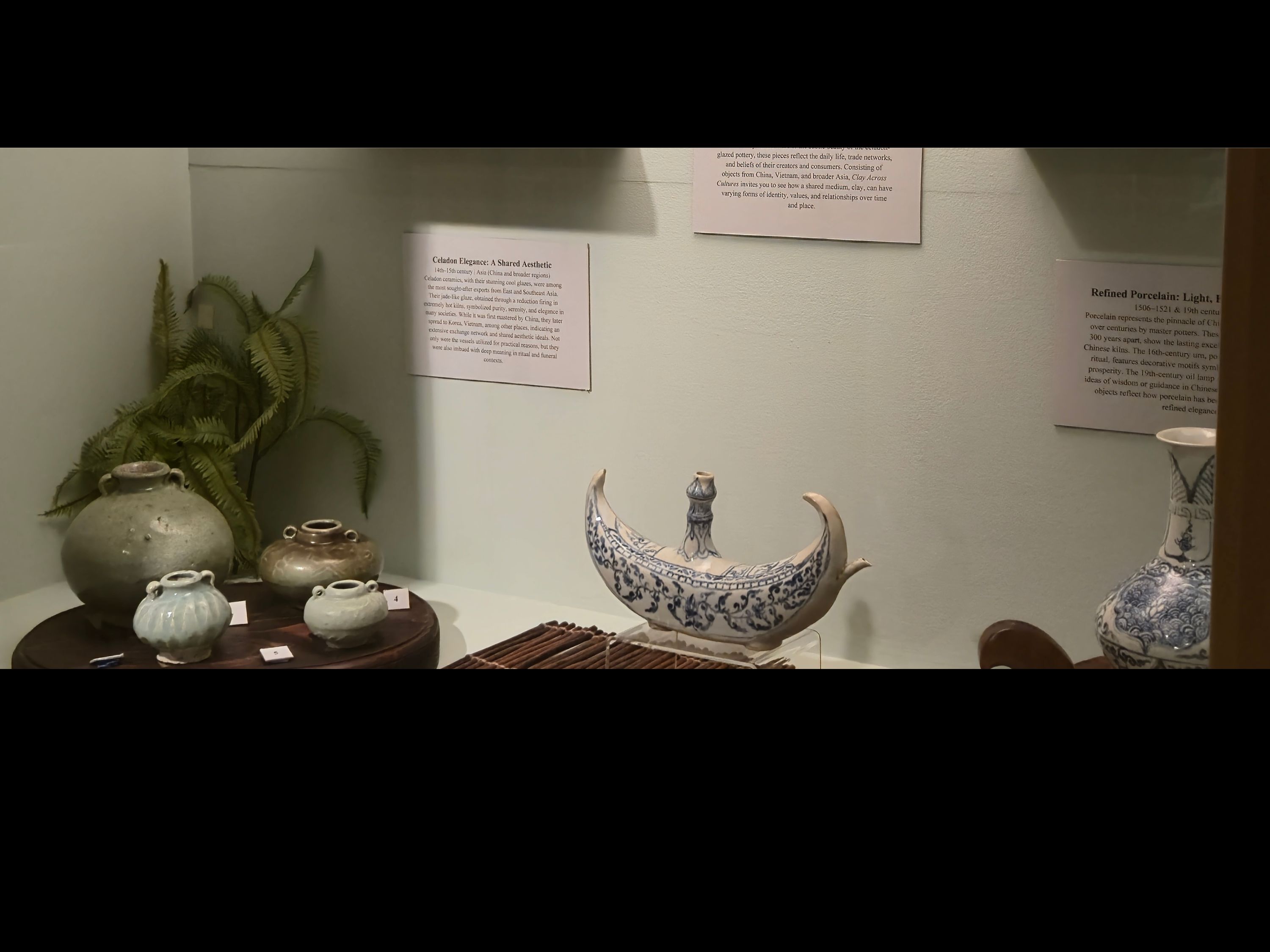Clay Across Cultures: Asia Ceramics
Spanning centuries and regions, this exhibit explores the artistry and cultural significance of Asian pottery. Whether functional forms of early earthenware or the subtle beauty of the celadon-glazed pottery, these pieces reflect the daily life, trade networks, and beliefs of their creators and consumers. Consisting of objects from China, Vietnam, and broader Asia, Clay Across Cultures invites you to see how a shared medium, clay, can have varying forms of identity, values, and relationships over time and place.
Forms of Function: Jarlets and Utility Ware
11th-16th century
China and Asia
While some ceramics were intended for decorative or ritual use, the majority, including these jars and jarlets, were household containers for oils, spices, and medicinal herbs, as well as food. Even domestic items, in most instances, carried subtle adornments or glazing, uniting utility and beauty together. These were also symbolic: curves suggested abundance, and certain colors or motifs were believed to produce health. Collectively, these ceramics not only exhibit practical needs, but also the cultural values of daily life in early Chinese society and neighboring regions.
Tall Jar
Jilin Province, China
11th-14th century
Earthenware
2020.01.002 Lowell D. Holmes Museum of Anthropology
Sawankhalok Ware Jarlet
China, Ming Dynasty
15th-16th century
Ceramic Stoneware
2020.01.069 Lowell D. Holmes Museum of Anthropology
Sawankhalok Sprouted Jarlet
China, Ming Dynasty
15th-16th century
Ceramic Stoneware
2020.01.070 Lowell D. Holmes Museum of Anthropology
Celadon Elegance: A Shared Aesthetic
14th-15th century
Asia (China and Broader Regions)
Celadon ceramics, with their stunning cool glazed, were among the most sought-after exports from East and Southeast Asia. Their jade-like glaze, obtained through a reduction firing in extremely hot kilns, symbolized purity, serenity, and elegance in many societies. While it was first mastered within China, they later spread to Korea, Vietnam, among other places, indicating an extensive exchange network and shared aesthetic ideals. Not only were the vessels utilized for practical reasons, but they were also imbued with deep meaning in ritual and funeral contexts.
Jarlet
Asia
14th-15th century
Celadon Glazed Ceramic
2020.01.084 Lowell D. Holmes Museum of Anthropology
Peony Design Jarlet
Fujian Province, China
14th-15th century
Celadon Glazed Ceramic
2020.01.078 Lowell D. Holmes Museum of Anthropology
Jarlet
Vietnam
16th century
Celadon Glazed Ceramic
2020.01.014 Lowell D. Holmes Museum of Anthropology
Bulbous Jar
Asia
14th-15th century
Celadon Glazed Ceramic
2020.01.092 Lowell D. Holmes Museum of Anthropology
Vietnamese Vessels: Local Craft, Global Influence
15th-16th century
Vietnam
During the Lê Dynasty, Vietnamese ceramics thrived, with coastal kilns becoming centers of innovation and trade. These jarlets, widely exported across Southeast Asia and the Indian Ocean world, reflect a blend of Chinese influence and regional identity. Floral motifs symbolized renewal, beauty, and the natural world, while the peacock feather design ---often associated with nobility and protection--- added layers of meaning. These decorative elements, paired with practical forms, reveal how everyday vessels also conveyed cultural values and artistic expression.
Bulbous Jarlet
Vietnam
14th-16th century
Ceramic
2020.01.032 Lowell D. Holmes Museum of Anthropology
Jarlet
Vietnam
14th-16th century Ceramic
2020.01.057 Lowell D. Holmes Museum of Anthropology
Bulbous Jarlet
Vietnam
15th-16th century
Ceramic
2020.01.028 Lowell D. Holmes Museum of Anthropology
Refined Porcelain: Light, Elegant, Durable
1506-1521 & 19th century
China
Porcelain represents the pinnacle of Chinese ceramics, perfected over centuries by master potters. These pieces, crafted nearly 300 years apart, show the lasting excellence and versatility of Chinese kilns. The 16th-century urn, possibly used for storage or ritual, features decorative motifs symbolizing protection and prosperity. The 19th-century oil lamp may naturally be tied to ideas of wisdom or guidance in Chinese culture. Together, these objects reflect how porcelain has been a lasting symbol of refined elegance.
Oil Lamp
China
19th century
Porcelain
2020.01.038 Lowell D. Holmes Museum of Anthropology
Urn
Fujian Province, China
1506-1521
Glazed Porcelain
2020.01.037 Lowell D. Holmes Museum of Anthropology
Martaban Storage Jar
China
18th century
Ceramic/Stoneware
This robust jar features a dragon soaring through clouds, an enduring symbol of power and protection in Asian traditions. Five lug handles circle the raised neck, blending utility with elegant form. Used to store liquids like water or oil, the jar's adornments and bold imagery reflect its dual role as a practical container and a vessel of cultural meaning. Widely traded, Martaban jars were prized across Asia for their durability and symbolic design
Donated by Melvin and Sylvia Epp
2020.01.094 Lowell D. Holmes Museum of Anthropology
Return To Echoes of Expression: A Cultural Symbolism Collective


